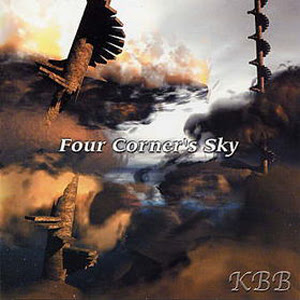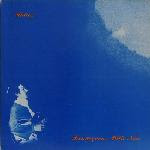1
KBB's musical genius remained intact, and even more, got enhanced and perfected as their splendid sophomore masterpiece "Four Corner's Sky" patently reveals.
Following in the path of their excellent debut album "Lost and Found", the quartet shows a major interest in increasing the jazzy essence of their music while adding some exciting refreshment and variation to their sound. The main compositions bear the usual strong feel. The opener 'Discontinuous Spiral' is a typical KBB refashion of the combined heritages of Jean-Luc Ponty's vintage stylish melodic fusion and di Meola-era Return to Forever's energetic sophistication. A strong opener, indeed. For the second meal of this feast, 'Kraken's Brain is Blasting', the band goes for a more somber ambience: for the first time, KBB ventures into neurotic territory, sorting out a well-balanced mixture of Mahavishnu's mystic side and King Crimson's exulting uneasiness.
Bassist Dani provides some excellent guitar leads that portray a big enough dose of fire as to serve an explosive challenge to violinist Tsuboy, a challenge assumed and responded with immaculate grace and convincing muscle. Definitely, track 2 is one solid peak in the album. After this display of power, comes a proper counterpoint, the beautiful ballad 'Horobi no Kawa'. It starts with a series of laconic piano chords, soon joined by the full band, which delivers a refined exercise on ethereal, melancholic moods worked on a simple yet effective basic melody. Just listening to these first three tracks in a row gives you that anticipation of a full masterpiece. The following two numbers are well constructed under the prototypical patterns of KBB jazz-prog. 'Back Side Edge' returns to the Ponty thing, marked by an initial catchy bass line set on a dynamic 7/8 tempo. 'Slave Nature', whose main motif is also constructed on a 7/8 tempo, preserves the same energy albeit a bit more restrained. The almost-Emersonian organ solo and guitar leads during the harder sections give an effective pompous adornment to the track, while the funky-based interlude softens things for a while. In many ways, you can describe 'Slave Nature' as a recapitulation of the recurrent moods of tracks 1 and 6. Then comes 'I Am not Here'. a mysterious title for the most inscrutable KBB composition ever. The band lets go momentarily of their melodic candor and splendorous vision in order to submerge itself into the realms of RIO. Yes, RIO. Assuming the lead role at its most compelling, Tsuboy's violin leads the band into a journey of sinister atmospheres, pretty much similar to early 80s Univers Zero. The interventions of Takahashi on piano and synth textures don't exactly help to make things brighter: the whole track seems to have been inspired by the dark side of the mind.
Very unusual for KBB standards, yet very revealing of how well can the band integrate diversity and unexpected ideas into the album as a whole. After the darkness comes the light again. The 10 minute closer 'Shironji' lifts off from when tracks 6 and 7 had left, leading to a gradually climatic display of progressive brightness. The successive guitar and violin leads help the track move from a more muscular mood into a more ethereal vibe, always energetic.
"Four Corner's Sky" is a good reason to keep infinite faith in the current Japanese prog scene. KBB has created a prog masterpiece for the new millennium - I wish I had gotten acquainted with this band's discography earlier since it's a genuine catalogue of wonders.
Following in the path of their excellent debut album "Lost and Found", the quartet shows a major interest in increasing the jazzy essence of their music while adding some exciting refreshment and variation to their sound. The main compositions bear the usual strong feel. The opener 'Discontinuous Spiral' is a typical KBB refashion of the combined heritages of Jean-Luc Ponty's vintage stylish melodic fusion and di Meola-era Return to Forever's energetic sophistication. A strong opener, indeed. For the second meal of this feast, 'Kraken's Brain is Blasting', the band goes for a more somber ambience: for the first time, KBB ventures into neurotic territory, sorting out a well-balanced mixture of Mahavishnu's mystic side and King Crimson's exulting uneasiness.
Bassist Dani provides some excellent guitar leads that portray a big enough dose of fire as to serve an explosive challenge to violinist Tsuboy, a challenge assumed and responded with immaculate grace and convincing muscle. Definitely, track 2 is one solid peak in the album. After this display of power, comes a proper counterpoint, the beautiful ballad 'Horobi no Kawa'. It starts with a series of laconic piano chords, soon joined by the full band, which delivers a refined exercise on ethereal, melancholic moods worked on a simple yet effective basic melody. Just listening to these first three tracks in a row gives you that anticipation of a full masterpiece. The following two numbers are well constructed under the prototypical patterns of KBB jazz-prog. 'Back Side Edge' returns to the Ponty thing, marked by an initial catchy bass line set on a dynamic 7/8 tempo. 'Slave Nature', whose main motif is also constructed on a 7/8 tempo, preserves the same energy albeit a bit more restrained. The almost-Emersonian organ solo and guitar leads during the harder sections give an effective pompous adornment to the track, while the funky-based interlude softens things for a while. In many ways, you can describe 'Slave Nature' as a recapitulation of the recurrent moods of tracks 1 and 6. Then comes 'I Am not Here'. a mysterious title for the most inscrutable KBB composition ever. The band lets go momentarily of their melodic candor and splendorous vision in order to submerge itself into the realms of RIO. Yes, RIO. Assuming the lead role at its most compelling, Tsuboy's violin leads the band into a journey of sinister atmospheres, pretty much similar to early 80s Univers Zero. The interventions of Takahashi on piano and synth textures don't exactly help to make things brighter: the whole track seems to have been inspired by the dark side of the mind.
Very unusual for KBB standards, yet very revealing of how well can the band integrate diversity and unexpected ideas into the album as a whole. After the darkness comes the light again. The 10 minute closer 'Shironji' lifts off from when tracks 6 and 7 had left, leading to a gradually climatic display of progressive brightness. The successive guitar and violin leads help the track move from a more muscular mood into a more ethereal vibe, always energetic.
"Four Corner's Sky" is a good reason to keep infinite faith in the current Japanese prog scene. KBB has created a prog masterpiece for the new millennium - I wish I had gotten acquainted with this band's discography earlier since it's a genuine catalogue of wonders.
:::Review by Cesar Inca:::
KBB - Four Corner's Sky (2003)
1. Discontinuous Spiral (7:16)
2. Kraken's Brain is Blasting (9:34)
3. Horobi no Kawa (6:51)
4. Back Side Edge (6:48)
5. Slave Nature (6:37)
6. I am not here (9:08)
7. Shironiji (10:10)
Credits
- Akihisa Tsuboy / violins, cellolin (7), guitars (5)
- Toshimitsu Takahashi / keyboards
- Dani / bass, guitars (2,7)
- Shirou Sugano / drums
KBB - Four Corner's Sky (2003)
1. Discontinuous Spiral (7:16)
2. Kraken's Brain is Blasting (9:34)
3. Horobi no Kawa (6:51)
4. Back Side Edge (6:48)
5. Slave Nature (6:37)
6. I am not here (9:08)
7. Shironiji (10:10)
Credits
- Akihisa Tsuboy / violins, cellolin (7), guitars (5)
- Toshimitsu Takahashi / keyboards
- Dani / bass, guitars (2,7)
- Shirou Sugano / drums














































